Did you know 92% of visitors report feeling a physical energy shift when standing in the volcanic caldera? This isn’t just another Mediterranean escape—it’s a portal to Earth’s primal forces. Your journey begins where black lava fields meet cobalt seas, creating a landscape so surreal it feels like walking through a geological time capsule.
The heart of this destination pulses with raw power. Steam rises from active fumaroles as you traverse craters wider than football fields. Locals call this magnetic pull “Nisyriasi”—an addictive force drawing explorers back for centuries. Pirates once hid in its coves, knights built fortresses on its cliffs, and today, travelers chase its therapeutic hot springs.
Imagine villages where whitewashed houses cling to hillsides like sugar cubes. Picture beaches where obsidian sand warms your feet as you gaze at fishing boats bobbing in turquoise waters. This is where adventure whispers through pine forests and history echoes in Byzantine monasteries.
Key Takeaways
- Walk across one of Europe’s largest active volcanic craters
- Discover thermal springs blending wellness with natural wonder
- Explore villages preserving 500-year-old traditions
- Experience the “Nisyriasi” phenomenon unique to this region
- Escape crowded hotspots with secluded black-sand beaches
Table of Clarity: Quick Information Guide for Nisyros Island
Ready to unlock the secrets of this volcanic marvel? Our curated collection of essential details helps you master your trip planning in minutes. Discover how to maximize every moment while respecting the island’s delicate balance of power and tranquility.
Key Facts & Figures
| Statistic | Detail | Significance |
|---|---|---|
| Land Area | 41 km² | Compact size allows full exploration in 2-3 days |
| Volcanic Age | 15,000 years | Youngest active volcano in Aegean Sea |
| Thermal Springs | 30-60°C | Natural spa experiences across 6 sites |
Highlights at a Glance
| Natural Wonder | Cultural Gem | Seasonal Event |
|---|---|---|
| Stefanos Crater | Porta Square Architecture | June Volcano Festival |
| Lakki Plain | Paleokastro Ruins | August Honey Harvest |
| Hydrothermal Vents | Monastery of Panagia Spiliani | September Grape Celebration |
Essential Practical Tips
| Category | Recommendation | Pro Tip |
|---|---|---|
| Transport | Daily ferries from Kos | Book AM tickets for calm seas |
| Currency | Euros (cash preferred) | ATM in Mandraki only |
| Safety | Closed-toe crater shoes | Carry windbreaker for microclimates |
The atmosphere shifts dramatically between coastal villages and volcanic highlands – make sure to pack layers. Mornings offer optimal visibility for crater hikes, while afternoons suit thermal spring relaxation. Locals recommend synchronizing your watch with the slow-paced rhythm of traditional life.
What Makes Nisyros Special?
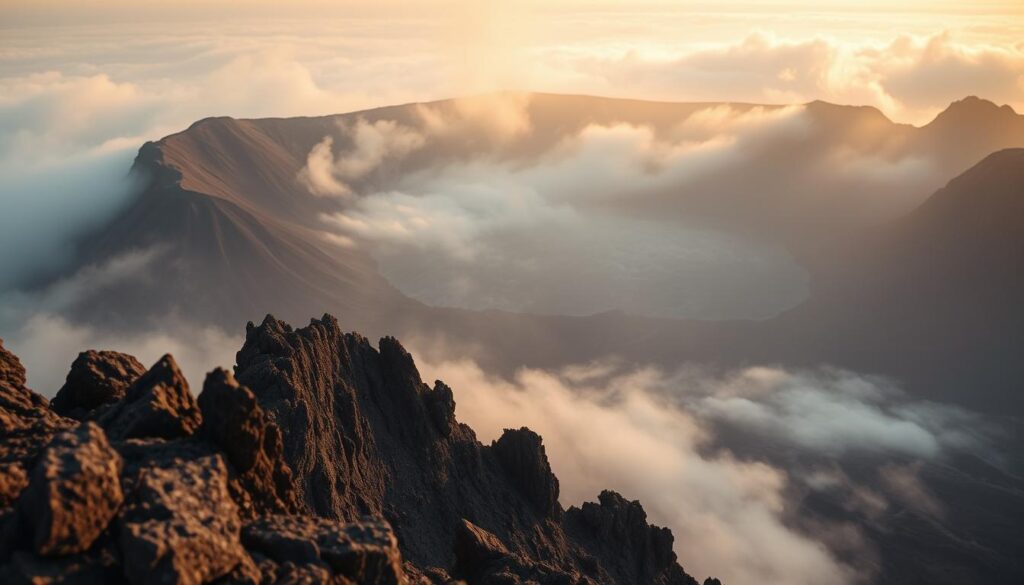
Have you ever stood where mythology meets molten earth? This land’s origin story begins with a titanic clash—gods hurling rocks across the Aegean to trap their enemies. That divine violence forged a living laboratory where fire and water still dance beneath your feet.
Power Beneath Your Boots
Walk across a 15,000-year-old volcanic theater larger than 12 football fields. Six steaming craters reveal rainbow-hued mineral deposits and hissing fumaroles. Guides joke, “You’re treading on Earth’s birthday cake—the candles are still lit.”
Stories Carved in Stone
Every cliff whispers legends of sea gods and buried giants. Locals still recount how pirates hid loot in lava tubes now used as wine cellars. “Our soil remembers everything,” says third-generation potter Maria Kappos, shaping clay from volcanic ash.
Charm That Defies Time
Black-sand beaches glow under twilight while village elders play backgammon in cobblestone squares. Thermal springs bubble at 140°F, mixing with cool seawater to create natural jacuzzis. It’s raw natural beauty perfected over millennia.
| Feature | Comparison | Unique Edge |
|---|---|---|
| Volcanic Access | Most active volcanoes require special permits | Walk freely into craters here |
| Cultural Layers | Common Greek islands showcase 1-2 historical periods | Displays 6 civilizations’ influences |
| Thermal Variety | Typical hot springs offer 1-2 temperatures | 6 distinct mineral compositions available |
This isn’t just scenery—it’s Earth’s autobiography written in lava flows and lemon groves. Visitors often leave clutching volcanic rocks like sacred talismans, forever changed by the beauty born from ancient chaos.
| Experience | Duration | Best Time |
|---|---|---|
| Crater Walk | 2 hours | Morning (cooler temps) |
| Hot Spring Dip | 30 mins | Sunset |
| Myth Trail Hike | 4 hours | Spring/Fall |
Exploring the Volcanic Wonders
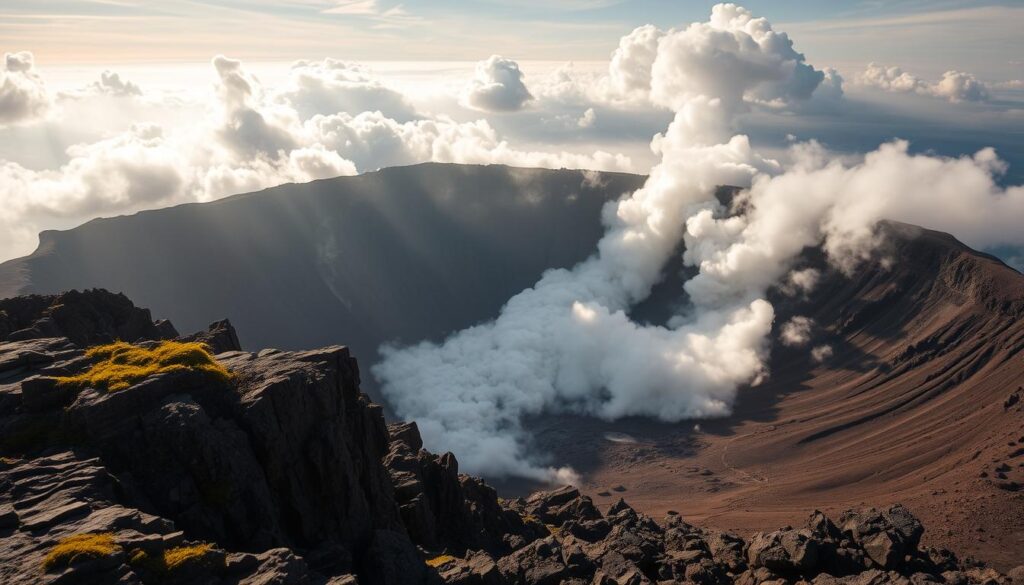
What if your next step could land on ground younger than human civilization? This lunar-like terrain pulses with geothermal energy, inviting you to walk across crust still cooling from its fiery birth. Here, Earth’s creative fury becomes your playground.
Crater Chronicles
Descend into Stefanos crater’s 27-meter depths, where sulfur crystals glitter like alien jewels. Nearby, Polyvotis stretches 260 meters wide—a colossal bowl named for the mythical giant trapped beneath. “These aren’t dormant holes—they’re breathing landscapes,” explains geologist Dr. Eleni Marouli.
Nature’s Healing Kitchens
Three hidden springs transform volcanic heat into wellness sanctuaries. At Thermiani, 60°C waters rich in potassium and magnesium soothe aching joints. Locals whisper about Avlaki’s iron-rich mud curing skin ailments for generations.
Smart Exploration Tactics
Bright ribbons flutter where new steam vents emerge overnight—nature’s warning signs. Always check wind direction; gases concentrate in still air. Sturdy soles protect against razor-sharp rocks, while light layers combat microclimate shifts.
This living laboratory rewards the prepared adventurer. Follow marked trails to witness rainbow-hued mineral deposits without disturbing delicate ecosystems. Remember—you’re walking across a geological heartbeat that still writes its own rules.
Experiencing Nisyros Island, Greece: Local Culture and Heritage
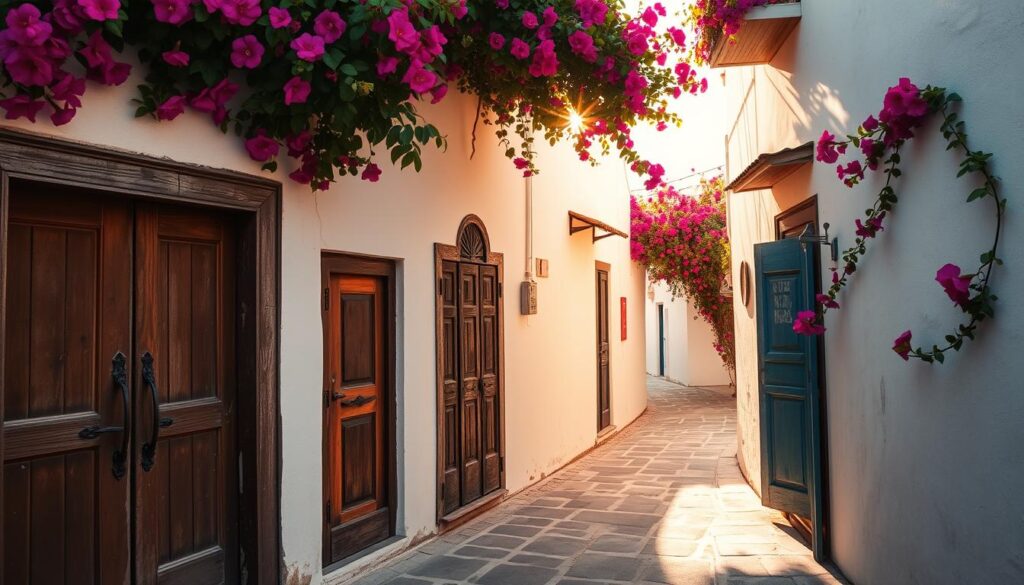
What if every cobblestone could whisper tales of centuries past? Step into villages where time moves to the rhythm of clinking goat bells and the scent of oregano hangs thick in mountain air. Here, heritage isn’t preserved behind glass—it pulses through daily life in steaming coffee cups and hand-painted shutters.
Must-Visit Villages and Historic Monuments
Mandraki’s white houses cascade toward the harbor like spilled sugar cubes, their cobalt doors framing views of fishing boats bobbing in turquoise waters. Climb winding alleys to discover Nikia’s crown jewel—Porta Square. Its pebbled mosaics depict mythical creatures, each stone laid by artisans honoring ancient techniques.
Emborios clings to volcanic slopes like a mountain goat, medieval castle ruins guarding secret passages beneath flower-filled courtyards. “These walls remember pirate ships and Ottoman sails,” explains local historian Yannis Kappos, pointing to weathered carvings in black trachyte stone.
Traditional Costumes and Local Stories
Thursday mornings bring a burst of crimson and gold to Mandraki’s square as elders don traditional dress—intricate embroidery telling family histories through symbolic patterns. “My grandmother’s apron shows 12 olive trees—one for each child she raised,” shares café owner Eleni Maroulis, serving spoon sweets made from volcanic soil-grown quinces.
In Pali, fishermen still mend nets using methods Homer described. Don’t miss the Hippocratic Baths—their mineral-rich waters now soothe modern travelers just as they healed ancient sailors. As sunset gilds Paleokastro’s cyclopean walls, you’ll understand why locals say “history here isn’t studied—it’s lived.”
Natural Highlights, Beaches and Outdoor Adventures
Ever wondered where black sands meet emerald waters under the Aegean sun? This landscape transforms every hike into a geological treasure hunt. Obsidian beaches like Lies Beach absorb sunlight, creating natural foot warmers as you stroll past tidal pools teeming with sea urchins.
Thrill-seekers conquer the Profitis Ilias trail before dawn—its summit reveals six neighboring islands floating in golden haze. Hidden coves near Pachia Ammos demand adventurous spirits; reach them by scrambling down basalt cliffs to discover private swimming grottos.
Kayakers paddle through sea caves where volcanic arches frame perfect sunset views. For ultimate rejuvenation, follow sulfur-scented breezes to steaming thermal springs that blend mineral-rich waters with cool sea currents. Locals swear by night swims at Hochlaki Bay—moonlight makes the black pebbles glitter like stardust.
This terrain rewards those who wander beyond maps. Pack sturdy shoes to chase waterfalls in spring or forage wild capers in summer. Every path here whispers: “Adventure lives where fire met water.”
FAQ
Q: Is Nisyros’ volcano still active?
A: Yes—the island’s volcano is considered dormant but not extinct. Its last eruption occurred in 1888, and the steaming craters and sulfur vents remind visitors of its raw power. Guided hikes let you safely explore the otherworldly caldera floor.
Q: When’s the best time to visit for mild weather?
A: Aim for May-June or September-October to avoid summer crowds and extreme heat. Spring brings wildflowers, while autumn offers warm seas—perfect for hiking volcanic trails or swimming in crystal-clear waters.
Q: How do I reach the island from Athens?
A: Daily ferries depart from Piraeus port (8-10 hours), or take a 50-minute flight to Kos followed by a 1-hour ferry. The journey rewards you with panoramic Aegean views and a slower pace of travel.
Q: What unique experiences can’t I miss?
A: Walk through Mandraki’s blue-and-white alleyways, soak in natural thermal springs near Emporios, and taste pougia—a local chickpea stew. Don’t skip the cliffside Monastery of Panagia Spiliani for sunset vistas.
Q: Are there beaches with volcanic features?
A: Absolutely. Pachia Ammos dazzles with dark sand and turquoise waters, while Lies Beach offers secluded pebble coves. For a surreal swim, visit Hot Springs Bay—where geothermal vents warm the sea.
Q: What cultural spots reveal local heritage?
A: Explore the 14th-century Paleokastro Castle ruins and the Folklore Museum in Nikia Village. Every August, the island comes alive during the Panigiria festivals—think traditional dances and grilled octopus feasts.
Q: Is hiking the crater safe?
A: With proper precautions, yes. Stick to marked trails, wear sturdy shoes, and carry water—summer temperatures can exceed 95°F (35°C). Guided tours provide helmets and insights into the volcano’s geological drama.
- Kaas Plateau Travel Guide 2026: Best Time to Visit, Bloom Season, How to Reach & FAQs
- What Is the Quirimbas Archipelago Mozambique Known For? Complete Travel & Nature Guide
- Is Angola Safe to Travel in 2025? Your Essential Guide to Health, Crime, and Landmine Safety
- What Animals Live in Bale Mountains Ethiopia? Complete Wildlife Guide
- What to Do in Damaraland — Complete Travel Guide for First-Timers
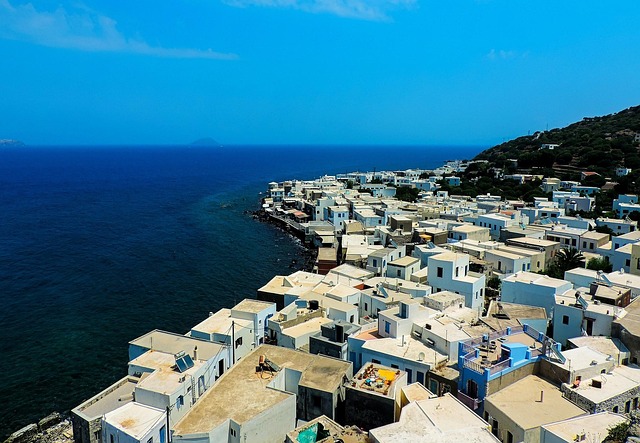

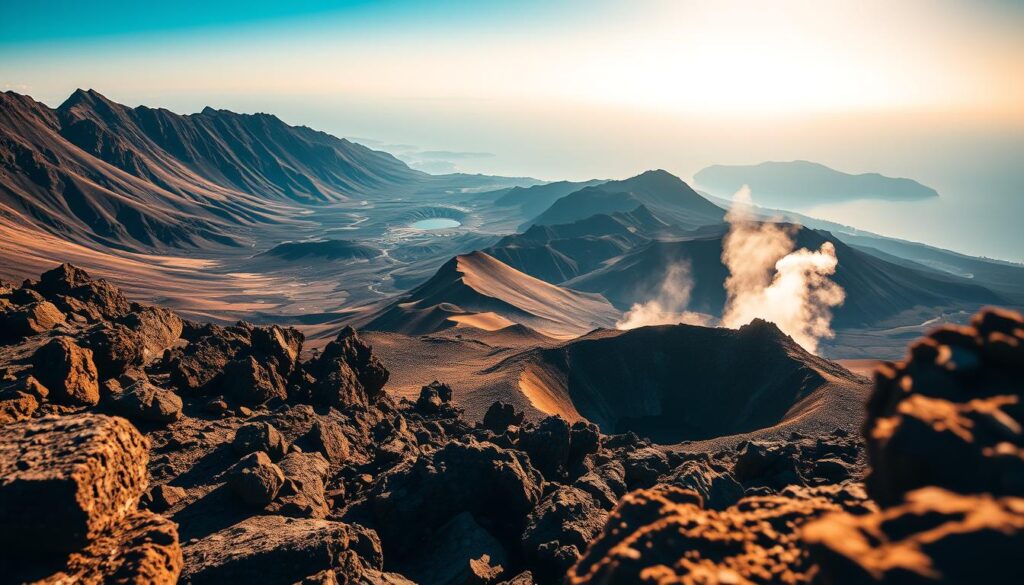
I have been surfing online more than three hours today, yet I never found any interesting article like yours. It is lovely price enough for me. In my view, if all website owners and bloggers made just right content as you did, the internet can be much more useful than ever before. "When you are content to be simply yourself and don't compare or compete, everybody will respect you." by Lao Tzu.
Thank you so much! Keep reading and sharing.
Your comment encourages us to write better articles.
Wow! Thank you! I constantly wanted to write on my website something like that. Can I implement a fragment of your post to my site?
I like this web site so much, saved to bookmarks.
I was examining some of your blog posts on this website and I believe this website is really informative! Continue posting.
Thanks for another great post. Where else could anybody get that type of info in such a perfect way of writing? I've a presentation next week, and I'm on the look for such info.
I am impressed with this website , really I am a big fan .
You really make it seem so easy with your presentation but I find this matter to be really something that I think I would never understand. It seems too complicated and extremely broad for me. I'm looking forward for your next post, I will try to get the hang of it!
I am incessantly thought about this, thanks for putting up.